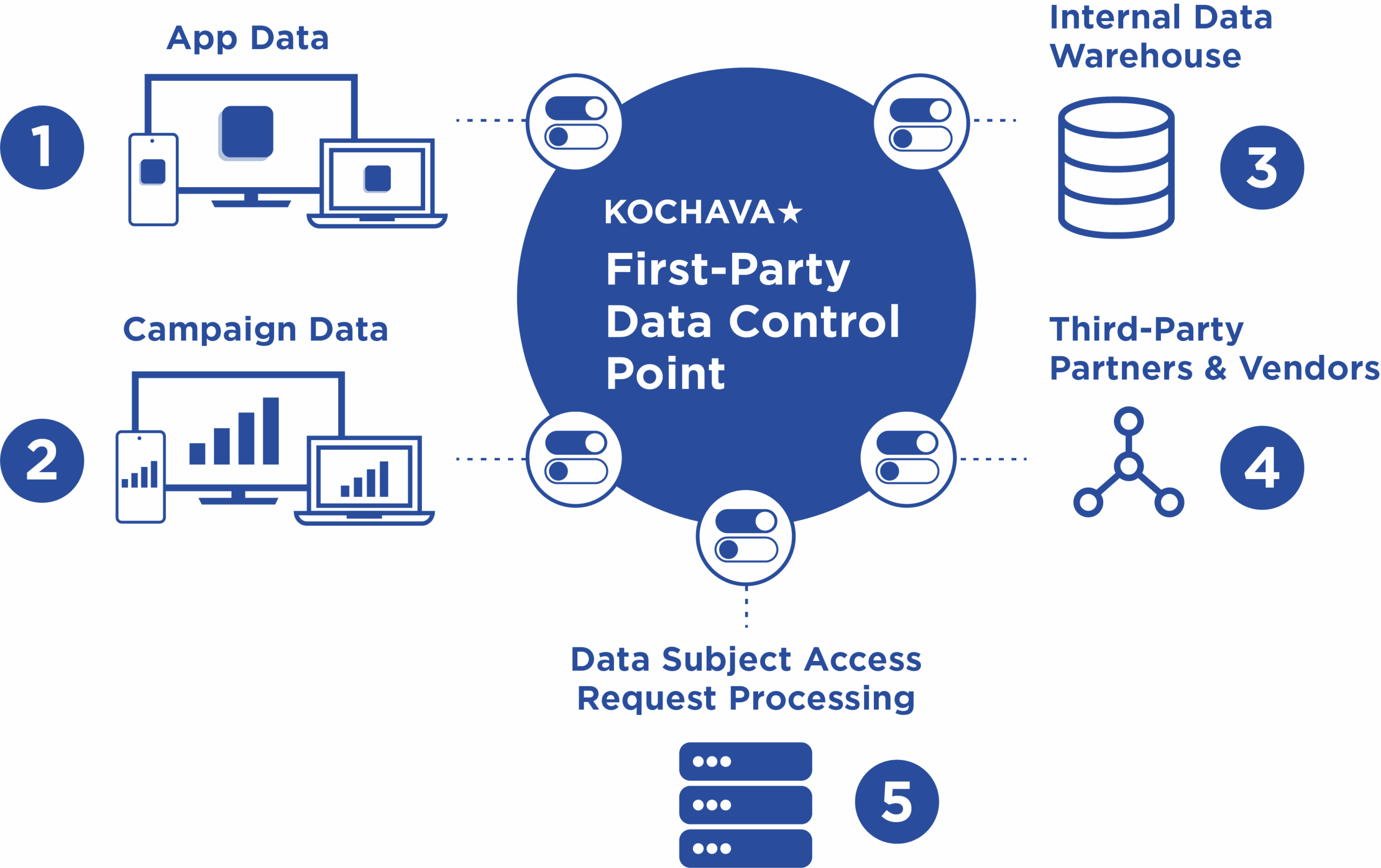Establishing your first-party data control point
DISCLAIMER: The information provided in this blog post is for general informational purposes only and does not constitute legal advice. It is not a substitute for obtaining professional legal advice from a qualified attorney. Always consult a licensed legal professional for advice specific to your situation.
TL;DR Summary
App compliance represents a strategic imperative extending beyond mere legal obligation, particularly in light of evolving privacy legislation such as GDPR and CCPA. Establishing a first-party data control point transforms compliance into a proactive advantage.
Surveying various compliance layers, encompassing governmental regulations, operating system and app store policies, industry standards, and media platform guidelines, we unpack how a measurement provider such as Kochava functions as a critical intermediary in this complex landscape. Kochava’s pivotal role as a first-party data control point is substantiated by its capabilities in data collection management (including unified consent and privacy-first attribution), data syndication control (facilitating partner management and data minimization), and comprehensive app compliance features (encompassing regulatory adaptability, robust documentation, and detailed reporting).
Readers looking to leverage Kochava as their app compliance copilot can request an app compliance consultation.
The world of apps across mobile, connected TV (CTV), and other devices has exploded over nearly two decades since the 2007 launch of the iPhone. The saying “There’s an app for that” has never been more true—and yet one could also say “There’s a regulation for that.” The complex web of compliance protocols, regulations, and user privacy policies that app developers and marketers must navigate has sprouted right alongside the proliferation of the app ecosystem.
App compliance isn’t just a legal checkbox—it’s a strategic imperative. And yet, with privacy laws including GDPR, CCPA, and emerging regulations constantly reshaping how brands collect and process consumer data, many marketers feel they’re playing defense in a game where the rules of engagement keep changing.

What if the script could be flipped? By establishing a robust first-party data control point within your app infrastructure, you can transform compliance from a reactive burden into a proactive advantage. A centralized control point puts you in the driver’s seat, allowing you to govern precisely what data enters your ecosystem, dictate how it’s processed and utilized, and control how it’s shared with partners and vendors beyond your walls—all while maintaining the flexibility to adapt to new regulations without overhauling your entire data strategy and growth stack.
The Many Layers of App Compliance
App compliance regulations and policies come from a number of different sources spanning governments, industry regulatory bodies, operating systems and app stores, media partners, and more.
Examples of app compliance at varying layers:
| Compliance Layer | Examples |
|---|---|
|
Government Regulations may impact user consent and opt-in requirements, data residency, transnational data sharing, and other variables based on the user’s location and/or residence status. |
|
|
Operating Systems & App Stores Policies may impact device identifier availability and usage, user tracking for marketing activities, device data collection, and other variables based on the user’s device type, operating system, and relevant app store(s). |
|
|
Industry Regulations and laws may govern how user data is collected, stored, processed, and/or syndicated relating to sensitive industries such as health or finance. |
|
|
Media Platforms Policies may impact how app data can be shared for advertising targeting, activation, and measurement, as well as how app marketers can access, use, retain, and action on performance reporting data provided by the media platform. |
|
Across this multitude of layers, specific regulations may govern how an app can
- Collect user data
- Process user data
- Store user data
- Syndicate user data
- Access and syndicate performance/attribution data
- Process data subject access requests (DSARs) for users/customers
- and more
Sitting atop all of these privacy layers, each brand/organization has legal and/or privacy teams making their own judgements about how best to comply and adhere to applicable compliance elements. This can leave you as the marketer or developer striking a delicate balancing act.

Enter Your First-Party Data Control Point
A next-generation mobile measurement partner (MMP) such as Kochava can act as the crucial intermediary—significantly streamlining app compliance through centralized data collection, governance, and control. While an MMP cannot provide you with official legal advice, it can offer helpful guidance and implementation documentation for control-point capabilities, which may include the following:
Data Collection Management
Unified Consent Framework
- Implement consent management across all marketing touchpoints, even shutting down client-side app measurement when necessary.
- Centralize capture of opt-in/opt-out preferences & consent strings from users.
- Automatically apply and/or syndicate consent status to all downstream partners.
- Support regional privacy frameworks (e.g., GDPR, CCPA, LGPD) with appropriate data collection rules.

Privacy-First Attribution
- Enable privacy-preserving measurement techniques (e.g., aggregated reporting, differential privacy, modeled conversions).
- Offer out-of-the-box support for privacy-enhancing technologies (e.g., Apple’s SKAN/AAK, Google Privacy Sandbox).
- Provide organizational controls to implement consent-based vs. anonymized tracking & attribution strategies.
- Provide fallback attribution methods (if applicable) when tracking is limited.
Data Syndication Control
Integrated Partner Management Hub
- Host granular permissioning to control which partners receive what data types.
- Apply real-time syndication controls to start/stop data sharing instantly.
- Store audit trails to track exactly what data is shared, when & with whom.
Data Minimization
- Offer configurable options to send only necessary data fields to each partner.
- Navigate data retention policies across the partner ecosystem.
- Provide automatic data anonymization, pseudonymization & even full redaction based on unique partner requirements.
- Support “right to be forgotten” requests across all syndication points.
App Compliance Features
Regulatory Adaptability
- Leverage preconfigured policy templates with settings for different jurisdictions, partners & platforms.
- Update data practices when regulations change, reducing legal & technical overhead of compliance management for organizations.
- Eliminate the need to manage individual partner compliance.
Documentation and Reporting
- Facilitate compliance reports for legal teams.
- Maintain detailed logs & audit trails for regulatory audits.
- Offer APIs for handling data subject access requests (DSARs).
By leveraging a next-generation MMP as a first-party data control point, organizations can maintain compliance while preserving the data insights needed for effective campaign optimization.
Creating Your 5-Step App Compliance Plan
If you’ve been charged with spearheading app compliance efforts within your organization or just want to better understand the elements involved, here’s a blueprint to set you on the right course. Be sure to work hand in hand with your legal and privacy teams along the way.
Step 1: Conduct Comprehensive Data Mapping & Update Your Privacy Policy
Map out every piece of user and/or device data your app collects, its purpose, where it’s stored, and with whom it’s shared. Work with your MMP to understand what data their software development kit (SDK) can be configured to collect. This information is crucial for developing a transparent privacy policy that informs users about your data practices, including the role of your measurement partner.
Step 2: Configure Consent Management
Managing user consent for data collection and processing—a requirement under regulations like GDPR and CCPA—may be accomplished via your MMP’s built-in consent management functionality (when available) or via a separate consent management platform (CMP). Consult your MMP to understand the consent management options available. If you do leverage a third-party CMP, ensure that it’s correctly integrated with your MMP’s SDK to control data flow based on user consent status (i.e., the MMP collects and processes data only from users who have given explicit permission).
Step 3: Implement Data Minimization & Privacy-Enhancing Features
Work with your MMP to activate privacy-enhancing features. This may include data minimization to collect only the data necessary for your advertising measurement goals, using aggregated or anonymized reporting where possible, and configuring data retention periods to delete user-level data automatically after a specified time.
Step 4: Establish a Clear DSAR (Data Subject Access Request) Workflow
Familiarize yourself with your MMP’s tools for handling data access and deletion requests. Establish a clear, documented internal process for verifying a user’s identity, then using the MMP’s platform to retrieve or erase a user’s data within the legally required timeframe. Kochava provides an API specifically for this purpose, enabling organizations to manage DSARs at scale.
Step 5: Regularly Audit and Validate Data Flows
Periodically audit your app’s MMP integration. For example, test that the consent mechanism works as expected (i.e., data is not sent without consent), verify that the MMP collects the data solely per your desired configurations, and ensure that all settings align with your stated privacy policy and current regulations.
Request an app compliance consultation with our sales engineering team.
App Compliance Use Cases
The following use cases illustrate real-world examples of streamlined app compliance leveraging Kochava as a first-party data control point.
Fintech App and Transnational Data Syndication
A fintech app captures certain data points and metrics on its customers. To grow its base of app users further, it wants to launch campaigns with new media partners. Due to financial regulations around data sharing, the app is unable to syndicate data for specific users to media partners headquartered in certain overseas countries.
The app leverages Kochava’s Data Controlled Flag feature to pass an indicator along with app installs and events for any user subject to this restriction. Within the Partner Configurations dashboard for any overseas media partner, the app team activates the Respect Data Controlled Flag feature. This disables data syndication to a partner for any app transaction with a “data_controlled” value of “true.” This enables the fintech app to maintain compliance with overseas data sharing related to their marketing activities.
QSR and iOS ATT Framework & SKAN
The privacy team at a quick service restaurant chain decides that absent user opt-in for tracking via Apple’s App Tracking Transparency (ATT) framework, they want to collect device signals only from iOS users in order to perform attribution to owned media served on their first-party websites and apps (e.g., web smart banners, cross-promo campaigns).
The app team leverages Kochava Privacy Profiles to configure data collection protocols based on a user’s ATT opt-in status, ensuring that opted-out users can be attributed only to owned media efforts. For their paid media activity across third-party ad networks, they leverage Kochava’s out-of-the-box support for Apple’s StoreKit Ad Network (SKAN). This enables them to track campaign performance in a privacy-preserving and compliant manner for their key channel partners.
Kochava: Your App Compliance Copilot
Amid all the complexities involved, Kochava serves as your essential app compliance copilot. The rules required by the advertising ecosystem are manifested and codified in our product—taking the guesswork and unwanted legwork out of app compliance.
Kochava provides first-party data control points, including:
Control Point 1: App data collection & processing according to regional consent frameworks, device platform restrictions, operating system policies & beyond
Control Point 2: Campaign data collection & attribution processing according to media partner-level policies & frameworks
Control Point 3: Secure data syndication to internal first-party data warehousing solutions
Control Point 4: Secure data syndication to third-party partners & vendors accounting for data sharing restrictions & policies at varying levels
Control Point 5: Scalable data subject access request (DSAR) processing

To connect with our sales engineering team for an app compliance consultation, please contact us.
If you’re an existing Kochava client and want to explore these features further for your account, connect with your Client Success Manager or email support@kochava.com.
Would you like to receive other helpful content? Subscribe to our newsletter.
Reader FAQ: How to Manage App Compliance
1. What is app compliance?
App compliance refers to adhering to the complex web of regulations, policies, and industry standards that govern how app developers and marketers collect, process, store, and syndicate user data. This includes governmental privacy laws (e.g., GDPR, CCPA), operating system and app store policies (e.g., Apple ATT, Google Play policies), industry-specific regulations (e.g., HIPAA), and media platform guidelines.
2. What is a first-party data control point and why is it important for app compliance?
A first-party data control point is a centralized system within your app infrastructure that allows you to govern precisely what data enters your ecosystem, how it’s processed and utilized, and how it’s shared with partners and vendors. It transforms compliance from a reactive burden into a proactive advantage by giving you direct control over your data, enabling flexibility to adapt to new regulations without overhauling your entire data strategy.
3. What are the different layers of app compliance that app developers and marketers need to consider?
App compliance encompasses multiple layers, including:
- Governmental regulations: For example, GDPR, CCPA, PIPL, CPPA, and LGPD, which impact user consent, data residency, and transnational data sharing.
- Operating systems & app stores: Policies from Android, Google Play Store, iOS, Apple App Store, HarmonyOS, HUAWEI AppGallery, and CTV platforms (Roku, VIZIO, LG) affect device identifier usage and user tracking.
- Industry standards: Regulations like HIPAA for healthcare, PCI DSS for payment cards, and GLBA for financial institutions govern data handling in sensitive industries.
- Media platforms: Policies from Google Ads, Meta/Facebook, Apple Ads, TikTok, and Snap influence how app data is shared for advertising, targeting, and measurement.
4. How can a mobile measurement partner (MMP) such as Kochava help with app compliance?
A next-generation MMP such as Kochava acts as a crucial intermediary, streamlining app compliance through centralized data collection, governance, and control. Kochava offers capabilities for:
- Data collection management: Including unified consent frameworks & privacy-first attribution.
- Data syndication control: Facilitating integrated partner management & data minimization.
- App compliance features: Encompassing regulatory adaptability, robust documentation & detailed reporting.
5. Can you provide a real-world example of how Kochava helps with app compliance?
One example is a fintech app managing transnational data syndication. Due to financial regulations, the app cannot send certain user data to media partners in specific overseas countries. By leveraging Kochava’s Data Controlled Flag feature, the app passes an indicator for restricted users. Within the Partner Configurations, the app team activates the Respect Data Controlled Flag for overseas partners, disabling data syndication for those specific transactions. This allows the fintech app to maintain compliance with overseas data sharing regulations.
6. Can I use this blog as a substitute for legal counsel?
No, this blog is not a substitute for obtaining legal counsel. The information provided in this blog post is for general informational purposes only and does not constitute legal advice.
Have additional app compliance questions? Contact us.




